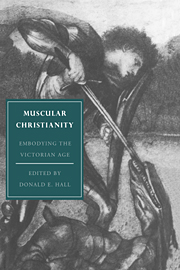Book contents
- Frontmatter
- Contents
- List of contributors
- Acknowledgments
- INTRODUCTION
- PART I FOUNDATIONS OF MUSCULAR CHRISTIANITY
- PART II VARIETIES OF MUSCULAR CHRISTIANITY
- PART III RESPONSES TO MUSCULAR CHRISTIANITY
- 8 The confidence man: empire and the deconstruction of muscular Christianity in The Mystery of Edwin Drood
- 9 The re-subjection of “Lucas Malet”: Charles Kingsley's daughter and the response to muscular Christianity
- 10 Pater's muscular aestheticism
- Index
9 - The re-subjection of “Lucas Malet”: Charles Kingsley's daughter and the response to muscular Christianity
from PART III - RESPONSES TO MUSCULAR CHRISTIANITY
Published online by Cambridge University Press: 05 March 2010
- Frontmatter
- Contents
- List of contributors
- Acknowledgments
- INTRODUCTION
- PART I FOUNDATIONS OF MUSCULAR CHRISTIANITY
- PART II VARIETIES OF MUSCULAR CHRISTIANITY
- PART III RESPONSES TO MUSCULAR CHRISTIANITY
- 8 The confidence man: empire and the deconstruction of muscular Christianity in The Mystery of Edwin Drood
- 9 The re-subjection of “Lucas Malet”: Charles Kingsley's daughter and the response to muscular Christianity
- 10 Pater's muscular aestheticism
- Index
Summary
But what prison? Where am I cloistered? I see nothing confining me. The prison is within myself, and it is I who am its captive.
Luce Irigaray, “And the one doesn't stir without the other” (60)How can this object of transaction claim a right to pleasure without removing her/itself from established commerce?
Luce Irigaray, This Sex which is not One (32)In 1902, Charles Kingsley's second daughter, Mary St. Leger Kingsley Harrison (1852–1931), became a convert to Roman Catholicism. Mrs. Harrison was already a public figure, well-known for the essays and fiction she wrote under the pen name of “Lucas Malet”; according to one contemporary critic, “the library public clamoured” for the half-dozen novels she published in the 1880s and 1890s (Courtney, “A Novelist of the 'Nineties,” 231). In interviews granted to newspapers and magazines, Mrs. Harrison simultaneously asserted her personal affection for her father and her deviation from his values and philosophy. Certainly her conversion came as no surprise to her friends, for “Lucas” – as she insisted they call her – had long been a rebel against “muscular Christianity.” As I will demonstrate, this rebellion is encoded in her most famous novel, The History of Sir Richard Calmady (1901).
Charles Kingsley was known, of course, for his belief in the sanctity of heterosexual married love; for his emphasis on “manly” strength and chivalry, particularly when exercised on behalf of women; and for his uncompromising hostility to the Church of Rome. In her youth, Mary Kingsley was a dutiful daughter.
- Type
- Chapter
- Information
- Muscular ChristianityEmbodying the Victorian Age, pp. 194 - 214Publisher: Cambridge University PressPrint publication year: 1994
- 1
- Cited by



